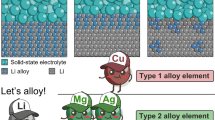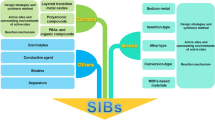Abstract
Silicon monoxide (SiO) is considered as a promising anode material for lithium-ion batteries (LIBs) due to its higher capacity and longer cycle life than those of graphite and silicon, respectively. In this study, glucose was developed as a suitable and inexpensive carbon source to synthesize SiO/C composite with a high performance. In addition, the effects of the calcination temperature and the amount of carbon source on the electrochemical performance of the SiO/C composite were investigated. The addition of 5 wt% glucose and a calcination temperature of 800 °C demonstrated the optimum conditions for SiO/C synthesis. The resultant SiO/C showed an initial charge capacity of 1259 mAh·g−1 and a high initial coulombic efficiency of 71.9%. A charge capacity of 850 mAh·g−1 after 100 cycles at 200 mA·g−1 was achieved, demonstrating the best value of the SiO/C-based materials. The composition changes of SiO under the calcination temperature played a significant role in the electrochemical performance. Overall, the obtained SiO/C material with a high capacity and good stability is suitable for LIB applications as an anode material.






Similar content being viewed by others
References
Arico AS, Bruce P, Scrosati B. Nanostructured materials for advanced energy conversion and storage devices. Nat Mater. 2005;4(5):366.
Armand M, Tarascon J. Building better batteries. Nature. 2008;451(7179):652.
An Y, Chen S, Zou M, Geng LB, Sun XZ, Zhang X, Wang K, Ma YW. Improving anode performances of lithium-ion capacitors employing carbon–Si composites. Rare Met. 2019;38(12):1113.
Li J, Yang JY, Wang JT, Lu SG. A scalable synthesis of silicon nanoparticles as high-performance anode material for lithium-ion batteries. Rare Met. 2019;38(3):199.
Sato K, Noguchi M, Demachi A, Oki N, Endo M. A mechanism of lithium storage in disordered carbons. Science. 1994;264(22):556.
Wu SJ, Wu ZH, Fang S, Qi XP, Yu B, Yang JY. A comparison of core–shell Si/C and embedded structure Si/C composites as negative materials for lithium-ion batteries. Rare Met. 2019. https://doi.org/10.1007/s12598-019-01354-8.
Deshpande R, Chen YT, Verbrugge MW. Modeling diffusion-induced stress in nanowire electrode structures. J Power Sources. 2010;195(15):5081.
Obrovac MN, Christensen L. Structural changes in silicon anodes during lithium insertion/extraction. Solid State Lett. 2004;7(5):A93.
Obrovac MN, Christensen L Le, Dahn JR. Alloy design for lithium-ion battery anodes. J Electrochem Soc. 2007;154(9):A849.
Aurbach D. Review of selected electrode-solution interactions which determine the performance of Li and Li-Ion batteries. J Power Sources. 2000;89(2):206.
Chan CK, Ruffo R, Hong SS, Cui Y. Surface chemistry and morphology of the solid electrolyte interphase on silicon nanowire lithium-ion battery anodes. J Power Sources. 2009;189(2):1132.
Wu ZH, Yang JY, Yu B, Shi BM, Zhao CR, Yu ZL. Self-healing alginate carboxymethyl chitosan porous scaffold as an effective binder for silicon anodes in lithium-ion batteries. Rare Met. 2019;38(9):832.
Zhang T, Gao J, Zhang HP, Yang LC. Preparation and electrochemical properties of core-shell Si/SiO nanocomposite as anode material for lithium ion batteries. Electrochem Commun. 2007;9(5):886.
Jeong G, Kim JH, Kim YU, Kim YJ. Multifunctional TiO2 coating for a SiO anode in Li-ion batteries. J Mater Chem. 2012;22(16):7999.
Schulmeister K, Mader W. TEM investigation on the structure of amorphous silicon monoxide. J Non-Cryst Solids. 2003;320(1–3):143.
Miyachi M, Yamamoto H, Kawai H, Ohta T, Shirakata M. Analysis of SiO anodes for lithium-ion batteries. J Electrochem Soc. 2005;152(10):A2089.
Hwa B, Kim JH, Sohn HJ. A new approach to synthesis of porous SiOx anode for Li-ion batteries via chemical etching of Si crystallites. Electrochim Acta. 2014;117(20):426.
Yamamura H, Nakanishi S. Reduction effect of irreversible capacity on SiO anode material heat-reacted with Fe2O3. J Power Sources. 2013;232(15):264.
Kim JH, Park CM, Kim H. Electrochemical behavior of SiO anode for Li secondary batteries. J Electroanal Chem. 2011;661(1):245.
Si Q, Hanai K, Ichikawa T, Phillippa MB, Hirano A, Imanishi N, Yamamoto O, Takeda Y. Improvement of cyclic behavior of a ball-milled SiO and carbon nanofiber composite anode for lithium-ion batteries. J Power Sources. 2011;196(22):9774.
Kim JH, Sohn HJ, Kim H, Jeong G, Choi W. Enhanced cycle performance of SiO-C composite anode for lithium-ion batteries. J Power Sources. 2007;170(2):456.
Hwa Y, Park CM, Sohn HJ. Modified SiO as a high performance anode for Li-ion batteries. J Power Sources. 2013;222:129.
Guo C, Wang D, Wang Q, Wang B, Liu T. A SiO/graphene nanocomposite as a high stability anode material for lithium-ion batteries. Int J Electrochem Sci. 2012;7(9):8745.
Nguyen DT, Nguyen CC, Kim JS, Kim JY, Song SW. Facile synthesis and high anode performance of carbon fiber-interwoven amorphous nano-SiOx/graphene for rechargeable lithium batteries. ACS Appl Mater Inter. 2013;5(21):11234.
Yuan X, Xin H, Qin X, Li X. Self-assembly of SiO/reduced graphene oxide composite as high-performance anode materials for Li-ion batteries. Electrochim Acta. 2015;155:251.
Chen Z, Qin Y, Amine K. Sun YK Role of Surface coating on cathode materials for lithium-ion batteries. Mater Chem. 2010;20(36):7606.
Liu WR, Yen YC, Wu HC, Martin W. Nano-porous SiO/carbon composite anode for lithium-ion batteries. J Appl Electrochem. 2009;39(9):1643.
Lu ZW, Xing LZ, Liu J. Microstructure and electrochemical performance of Si–SiO2–C composites as the negative material for Li-ion batteries. J Power Sources. 2010;195(13):4304.
Wu WJ, Shi J, Liang YH, Liu F, Peng Y, Yang HB. A low-cost and advanced SiOx–C composite with hierarchical structure as an anode material for lithium-ion batteries. Phys Chem Chem Phys. 2015;17(20):13451.
Wang J, Zhao HL, He JC, Wang CM, Wang J. Nano-sized SiOx/C composite anode for lithium ion batteries. J Power Sources. 2011;196(10):4811.
Guo H, Mao R, Yang XJ, Chen J. Hollow nanotubular SiOx templated by cellulose fibers for lithium ion batteries. Electrochim Acta. 2012;74:271.
Lv PP, Zhao HL, Gao CH, Zhang TH, Liu X. Highly efficient and scalable synthesis of SiOx/C composite with core-shell nanostructure as high-performance anode material for lithium ion batteries. Electrochim Acta. 2015;152:345.
Lv PP, Zhao HL, Gao CH, Zhang TH, Liu X. SiOx–C dual-phase glass for lithium ion battery anode with high capacity and stable cycling performance. J Power Sources. 2015;274:542.
Yang J, Takeda Y, Imanishi N, Capiglia C, Xie JY, Yamamoto O. SiOx based anodes for secondary lithium batteries. Solid State Ionics. 2002;152:125.
Wang J, Yang J, Tang Y, Liu J, Zhang Y, Liang G. Size-dependent surface phase change of lithium iron phosphate during carbon coating. Nat Commun. 2014;5:4415.
Morita T, Takami N. Nano Si cluster-SiOx-C composite material as high-capacity anode material for rechargeable lithium batteries. J Electrochem Soc. 2006;153(2):A425.
Wang N, Tang Y, Zhang Y, Lee C. Si nanowires grown from silicon oxide. Chem Phys Lett. 1999;299(2):237.
Wang J, Zhou M, Tan G, Chen S, Wu F, Lu J, Amine K. Encapsulating micronano Si/SiOx into conjugated nitrogen-doped carbon as binder-free monolithic anodes for advanced lithium ion batteries. Nanoscale. 2015;7(17):8023.
Xia M, Zhou Z, Su YF, Li YR, Wu YF, Zhang HB. Scalable synthesis SiO@C anode by fluidization thermal chemical vapor deposition in fluidized bed reactor for high-energy lithium-ion battery. Appl Surf Sci. 2019;467:298.
Gnanaraj JS, Levi M, Levi E, Salitra G, Aurbach D, Fischer JE. Comparison between the electrochemical behavior of disordered carbons and graphite electrodes in connection with their structure. J Electrochem Soc. 2001;148(6):A525.
Acknowledgements
This work was financially supported by a Fund Project from Education Department of Jiangxi Province (No.KJLD14008) and the Special Fund Project for Graduate Innovation of Nanchang University (No.CX2017005).
Author information
Authors and Affiliations
Corresponding author
Rights and permissions
About this article
Cite this article
Wu, ZL., Ji, SB., Liu, LK. et al. High-performance SiO/C as anode materials for lithium-ion batteries using commercial SiO and glucose as raw materials. Rare Met. 40, 1110–1117 (2021). https://doi.org/10.1007/s12598-020-01445-x
Received:
Revised:
Accepted:
Published:
Issue Date:
DOI: https://doi.org/10.1007/s12598-020-01445-x




